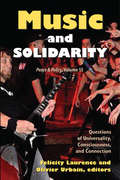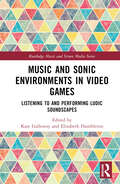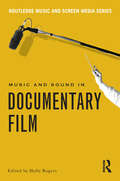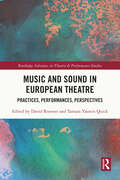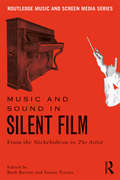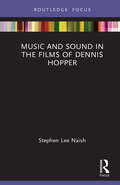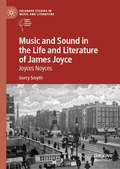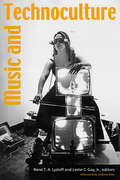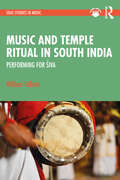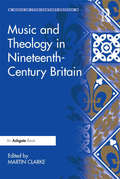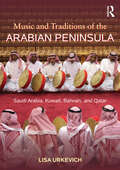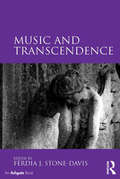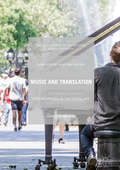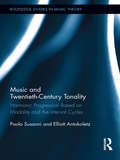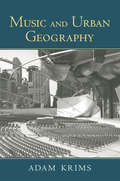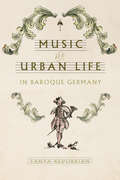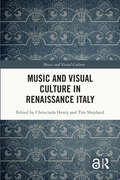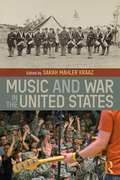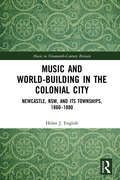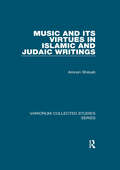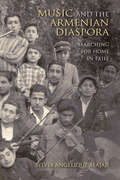- Table View
- List View
Music and Solidarity: Questions of Universality, Consciousness, and Connection (Peace and Policy #15)
by Felicity Laurence Olivier UrbainThe philosopher Christopher Small suggests that musical meanings are concerned with relationships, both with other human beings and with the world, and that music functions as a means of exploration, affirmation, and celebration of those relationships. If members of different social groups have different values, or different concepts of ideal relationships, then the kinds of performances that enact those relationships will differ from one another.Using music to express benevolent intentions is not, in general, one of its most obvious functions. In fact, military music has been used throughout history to destroy cross-cultural communion. Music is also a powerful and ubiquitous tool in propaganda, and in facilitating various political projects in all kinds of inventive ways that have nothing much to do with the pursuit of peaceful and cooperative intercultural understanding, or with helping people address issues of injustice.This text moves far beyond the knowledge of music's power upon humans, however this may be conceived and explained. It addresses a field of inquiry that is still a tiny endeavor, at least in comparison with all other academic efforts in the world. The sparseness of serious theoretical engagement with the topic of music's potential role in the area of peace and policy is echoed by how little music is directly used in the "real world" for building a more humane consciousness. Finding ways to that goal is the purpose of this work.
Music and Sonic Environments in Video Games: Listening to and Performing Ludic Soundscapes (Routledge Music and Screen Media Series)
by Kate Galloway and Elizabeth HambletonMusic and Sonic Environments in Video Games brings together a range of perspectives that explore how music and sound in video games interact with virtual and real environments, often in innovative and unexpected ways. Drawing on a range of game case studies and disciplinary perspectives, the contributors consider the sonic environment in games as its own storytelling medium. Highlighting how dynamic video game soundscapes respond to players’ movements, engage them in collaborative composition, and actively contribute to worldbuilding, the chapters discuss topics including genre conventions around soundscape design, how sonic environments shape players’ perceptions, how game sound and music model ecological processes and nonhuman relationships, and issues of cultural and geographic representation.Together, the essays in this volume bring game music and sound into the environmental humanities and transform our understanding of sonic environments as an essential part of storytelling in interactive media. Engaging a wide variety of game genres and communities of play, this book will be of interest to students and scholars of music, media studies, critical game studies, popular culture, and sound studies.
Music and Sound in Documentary Film: Real Listening
by Holly RogersThis collection of fourteen essays provides a rich and detailed history of the relationship between and music and image in documentary films, exploring the often overlooked role of music in the genre and its subsequent impact on an audience’s perception of reality and fiction. Exploring examples of documentary films which make use of soundtrack music, from an interdisciplinary perspective, Music and Sound in Documentary Film is the first in-depth treatment on the use of music in the nonfiction film and will appeal to scholars and students working in the intersection of music and film and media studies.
Music and Sound in European Theatre: Practices, Performances, Perspectives (Routledge Advances in Theatre & Performance Studies)
by David Roesner Tamara Yasmin QuickThe need for a research volume on European theatre music and sound is almost self-evident.Musical and sonic practices have been an integral part of theatre ever since the artform was first established 2,500 years ago: not just in subsequent genres that are explicitly driven by music, such as opera, operetta, ballet, or musical theatre, but in all kinds of theatrical forms and conventions. Conversely, academic recognition of the role of theatre music, its aesthetics, creative processes, authorships, traditions, and innovations is still insufficient. This volume unites experts from different disciplines and backgrounds to make a significant contribution to the much-needed discourse on theatre music. The term itself is a shapeshifter that signifies different phenomena at different times: the book thus deliberately casts a wide net to explore both the highly contextual terminologies and the many ways in which different times and cultures understand ‘theatre music’. By treating theatre music as a practice, focusing on its role in creating and watching performances, the book appeals to a wide range of readerships: researchers and students of all levels, journalists, audiences, and practitioners.It will be useful to universities and conservatoires alike and relevant for many disciplines in the humanities.
Music and Sound in Silent Film: From the Nickelodeon to The Artist
by Simon Trezise Ruth BartonDespite their name, the silent films of the early cinematic era were frequently accompanied by music and other sound elements of many kinds, including mechanical instruments, live performers, and audience sing-alongs. The 12 chapters in this concise book explore the multitude of functions filled by music in the rapidly changing context of the silent film era, as the concept of cinema itself developed. Examples are drawn from around the globe and across the history of silent film, both during the classic era of silent film and later uses of the silent format. With contributors drawn from film studies and music disciplines, and including both senior and emerging scholars, Music and Sound in Silent Film offers an essential introduction to the origins of film music and the cinematic art form.
Music and Sound in the Films of Dennis Hopper (Filmmakers and Their Soundtracks)
by Stephen Lee NaishAcross his directorial films, American filmmaker Dennis Hopper used music and sound to propel the narrative, signpost the era in which the films were made, and delineate the characters’ place within American culture. This book explores five of Hopper’s films to show how this deep engagement with music to build character and setting continued throughout his career, as Hopper used folk, punk, hip-hop, and jazz to shape the worlds of his films in ways that influenced other filmmakers and foreshadowed the advent of the music video format.The author traces Hopper’s distinctive approach to the use of music through films from 1969 to 1990, including his innovative use of popular rock, pop, and folk in Easy Rider, his blending of diegetic performances of folk and Peruvian indigenous music in The Last Movie, his use of punk rock in Out of the Blue, incorporation of hip-hop and rap in Colors, and commissioning of a jazz/blues soundtrack by Miles Davis and John Lee Hooker for The Hot Spot. Uncovering the film soundtrack as a vital piece of the narrative, this concise and accessible book offers insights for academic readers in music and film studies, as well as all those interested in Hopper’s work.
Music and Sound in the Life and Literature of James Joyce: Joyces Noyces (Palgrave Studies in Music and Literature)
by Gerry SmythMusic and Sound in the Life and Literature of James Joyce: Joyces Noyces offers a fresh perspective on the Irish writer James Joyce’s much-noted obsession with music. This book provides an overview of a century-old critical tradition focused on Joyce and music, as well as six in-depth case studies which revisit material from the writer’s career in the light of new and emerging theories. Considering both Irish cultural history and the European art music tradition, the book combines approaches from cultural musicology, critical theory, sound studies and Irish studies. Chapters explore Joyce’s use of repetition, his response to literary Wagnerism, the role and status of music in the aesthetic and political debates of the fin de siècle, music and cultural nationalism, ubiquitous urban sound and ‘shanty aesthetics’. Gerry Smyth revitalizes Joyce’s work in relation to the ‘noisy’ world in which the author wrote (and his audience read) his work.
Music and Sound in the Worlds of Michel Gondry (Filmmakers and Their Soundtracks)
by Kate McQuistonMichel Gondry’s directorial work buzzes with playfulness and invention: in a body of work that includes feature films such as Eternal Sunshine of the Spotless Mind and The Science of Sleep, to music videos, commercials, television episodes, and documentaries, he has experimented with blending animation and live action, complex narrative structures, and philosophical subject matter. Central to that experimentation is Gondry’s use of music and sound, which this book addresses in a new detailed study. Kate McQuiston examines the hybrid nature of Gondry’s work, his process of collaboration, how he uses sound and music to create a highly stylized reinforcement of often-elusive subjects such as psychology, dreams, the loss of memory, and the fraught relationship between humans and the environment. This concise volume provides new insight into Gondry’s richly creative multimedia productions, and their distinctive use of the soundtrack.
Music and Technoculture
by Andrew Ross Leslie C. Gay Jr. René T. LysloffMoving from web to field, from Victorian parlor to 21st-century mall, the 15 essays gathered here yield new insights regarding the intersection of local culture, musical creativity and technological possibilities. Inspired by the concept of "technoculture," the authors locate technology squarely in the middle of expressive culture: they are concerned with how technology culturally informs and infuses aspects of everyday life and musical experience, and they argue that this merger does not necessarily result in a "cultural grayout," but instead often produces exciting new possibilities. In this collection, we find evidence of musical practices and ways of knowing music that are informed or even significantly transformed by new technologies, yet remain profoundly local in style and meaning. CONTRIBUTORS: Leslie C. Gay, Jr., Kai Fikentscher, Tong Soon Lee, René T. A. Lysloff, Matthew Malsky, Charity Marsh, Marc Perlman, Thomas Porcello, Andrew Ross, David Sanjek, jonathan Sterne, Janet L. Sturman, Timothy D. Taylor, Paul Théberge, Melissa West, Deborah Wong.Ebook Edition Note: Four of the 26 illustrations, and the cover illustration, have been redacted.
Music and Temple Ritual in South India: Performing for Śiva (SOAS Studies in Music)
by William TallotteMusic and Temple Ritual in South India: Performing for Śiva documents the musical practices of the periya mēḷam, a South Indian instrumental ensemble of professional musicians who perform during the rituals and festivals of high-caste (Brahmanical) Tamil Hindu temples dedicated to the Pan-Indian god Śiva – an important patron of music since at least the tenth century. It explores the ways in which music and ritual are mutually constitutive, illuminating the cultural logics whereby performing and listening are integral to the kinetic, sensory and affective experiences that enable, shape and stimulate ritual communication in present-day devotional Hinduism. More than a rich and vivid ethnographic description of a local tradition, the book also develops a comprehensive and original analytical model, in which music is understood as both a situated and creative activity, and where the fluid relationship between humans and non-humans, in this case divine beings, is truly taken into consideration.
Music and Theology in Nineteenth-Century Britain (Music in Nineteenth-Century Britain)
by Martin V. ClarkeThe interrelationship of music and theology is a burgeoning area of scholarship in which conceptual issues have been explored by musicologists and theologians including Jeremy Begbie, Quentin Faulkner and Jon Michael Spencer. Their important work has opened up opportunities for focussed, critical studies of the ways in which music and theology can be seen to interact in specific repertoires, genres, and institutions as well as the work of particular composers, religious leaders and scholars. This collection of essays explores such areas in relation to the religious, musical and social history of nineteenth-century Britain. The book does not simply present a history of sacred music of the period, but examines the role of music in the diverse religious life of a century that encompassed the Oxford Movement, Catholic Emancipation, religious revivals involving many different denominations, the production of several landmark hymnals and greater legal recognition for religions other than Christianity. The book therefore provides a valuable guide to the music of this complex historical period.
Music and Traditions of the Arabian Peninsula: Saudi Arabia, Kuwait, Bahrain, and Qatar
by Lisa UrkevichMusic and Traditions of the Arabian Peninsula provides a pioneering overview of folk and traditional urban music, along with dance and rituals, of Saudi Arabia and the Upper Gulf States of Kuwait, Bahrain, and Qatar. The nineteen chapters introduce variegated regions and subcultures and their rich and dynamic musical arts, many of which heretofore have been unknown beyond local communities. The book contains insightful descriptions of genres, instruments, poetry, and performance practices of the desert heartland (Najd), the Arabian/Persian Gulf shores, the great western cities including Makkah and Medinah, the southwestern mountains, and the hot Red Sea coast. Musical customs of distinctive groups such as Bedouin, seafarers, and regional women are explored. The book is packaged with an audio CD and almost 200 images including a full color photo essay, numerous music transcriptions, a glossary with over 400 specialized terms, and original Arabic script alongside key words to assist with further research. This book provides a much-needed introduction and organizational structure for the diverse and complex musical arts of the region.
Music and Transcendence
by Ferdia J. Stone-DavisMusic and Transcendence explores the ways in which music relates to transcendence by bringing together the disciplines of musicology, philosophy and theology, thereby uncovering congruencies between them that have often been obscured. Music has the capacity to take one outside of oneself and place one in relation to that which is ’other’. <P><P> This ’other’ can be conceived in an ’absolute’ sense, insofar as music can be thought to place the self in relation to a divine ’other’ beyond the human frame of existence. However, the ’other’ can equally well be conceived in an ’immanent’ (or secular) sense, as music is a human activity that relates to other cultural practices. Music here places the self in relation to other people and to the world more generally, shaping how the world is understood, without any reference to a God or gods. The book examines how music has not only played a significant role in many philosophical and theological accounts of the nature of existence and the self, but also provides a valuable resource for the creation of meaning on a day-to-day basis.
Music and Translation: New Mediations in the Digital Age (Palgrave Studies in Translating and Interpreting)
by Lucile DesblacheThis book explores how transformations and translations shape musical meanings, developments and the perception of music across cultures. Starting with the concept of music as multimodal text, the author understands translation as the process of transferring a text from one language – verbal or not – into another, interlingually, intralingually or intersemiotically, as well as the products that are derived from this process. She situates music and translation within their contemporary global context, examining the tensions between local and global, cosmopolitan and national, and universal and specific settings, to arrive at a celebration of the translational power of music and an in-depth study of how musical texts are translated. This book will be of interest to translation studies scholars who want to broaden their horizons, as well as to musicians and music scholars seeking to understand how cultural exchange and dissemination can be driven by translation.
Music and Twentieth-Century Tonality: Harmonic Progression Based on Modality and the Interval Cycles (Routledge Studies in Music Theory)
by Elliott Antokoletz Paolo SusanniThis book explores the web of pitch relations that generates the musical language of non-serialized twelve-tone music and supplies both the analytical materials and methods necessary for analyses of a vast proportion of the 20th century musical repertoire. It does so in a simple, clear, and systematic manner to promote an easily accessible and global understanding of this music. Since the chromatic scale is the primary source for the pitch materials of 20th-century music, common sub-collections of the various modes and interval cycles serve as the basis for their mutual transformation. It is precisely this peculiarity of the non-serialized twelve-tone system that allows for an array of pitch relations and modal techniques hitherto perceived difficult if not impossible to analyze. Susanni and Antokoletz present the principles, concepts, and materials employed for analysis using a unique theoretic-analytical approach to the new musical language. The book contains a large number of original analyses that explore a host of composers including Ives, Stravinsky, Bartók, Messiaen, Cage, Debussy, Copland, and many more, providing insight into the music of the tonal revolution of the twentieth century and contributing an important perspective to how music works in general.
Music and Urban Geography
by Adam KrimsMusic and Urban Geography is the first book to theorize musical aspects of the tremendous changes that have overtaken major cities in the developed world over the past few decades. Drawing on musicology, music theory, urban geography, and historical materialism, Krims maps changes not only in how music represents cities, but also in how music sounds and is deployed socially in new urban contexts. Taking on venerable musicological debates from entirely new perspectives, Krims argues that the cultural-studies approach now predominant in cultural musicology fails to address contemporary realities of production and consumption; instead, the social effects of space and new patterns of urban production play a shaping role, in which music takes on new forms and functions, with representation playing a significant but not always decisive role. While music scholars increasingly concern themselves with place, Krims theorizes it together with the shaping role of space. Pushing urban geography into new cultural contexts Music and Urban Geography will offer those concerned with the social effects of space newtheoretical models. Ranging from Anonymous 4 to Alanis Morissette, from Curaçao to Seattle, Music and Urban Geography presents a truly wide-ranging, interdisciplinary, and theoretically ambitious view of both musical and urban change.
Music and Urban Life in Baroque Germany (Studies in Early Modern German History)
by Tanya KevorkianMusic and Urban Life in Baroque Germany offers a new narrative of Baroque music, accessible to non-music specialists, in which Tanya Kevorkian defines the era in terms of social dynamics rather than style and genre development. Towns were crucial sites of music-making. Kevorkian explores how performance was integrated into and indispensable to everyday routines, celebrations such as weddings, and political culture. Training and funding likewise emerged from and were integrated into urban life. Ordinary artisans, students, and musical tower guards as well as powerful city councilors contributed to the production and reception of music. This book illuminates the processes at play in fascinating ways.Challenging ideas of "elite" and "popular" culture, Kevorkian examines five central and southern German towns—Augsburg, Munich, Erfurt, Gotha, and Leipzig—to reconstruct a vibrant urban musical culture held in common by townspeople of all ranks. Outdoor acoustic communication, often hovering between musical and nonmusical sound, was essential to the functioning of these towns. As Kevorkian shows, that sonic communication was linked to the music and musicians heard in homes, taverns, and churches. Early modern urban environments and dynamics produced both the giants of the Baroque era, such as Johann Sebastian Bach and Georg Philipp Telemann, and the music that townspeople heard daily. This book offers a significant rediscovery of a rich, unique, and understudied musical culture.Received a subvention award from the Margarita M. Hanson Fund and the Donna Cardamone Jackson Fund of the American Musicological Society.
Music and Victorian Liberalism: Composing the Liberal Subject
by Sarah CollinsThe discourse on Victorian liberalism has long been explored by scholars of literature, with reference to politics, ethics and aesthetics. Yet studies which focus on music in Victorian culture have paid less attention to these debates, leaving a rich collection of historical and archival detail on the periphery of our understanding of the aesthetic aspects of liberalism. From the impact of the National Sunday League to the reception of Wagner in London, this collection of essays aims to nuance current approaches to the aesthetic facets of liberalism, examining the interaction between music and liberal discourses in Victorian Britain. Taking a multidisciplinary approach, it expands upon previous empirical studies to identify uses and contexts of music across elite and amateur spheres. The significance of music in the Victorian period and its subsequent impact on modern conceptions of self-hood and community is uncovered, revealing a new dimension of Victorian liberalism.
Music and Visual Culture in Renaissance Italy (Music and Visual Culture)
by Tim Shephard Chriscinda HenryThe chapters in this volume explore the relationship between music and art in Italy across the long sixteenth century, considering an era when music-making was both a subject of Italian painting and a central metaphor in treatises on the arts. Beginning in the fifteenth century, transformations emerge in the depiction of music within visual arts, the conceptualization of music in ethics and poetics, and in the practice of musical harmony. This book brings together contributors from across musicology and art history to consider the trajectories of these changes and the connections between them, both in theory and in the practices of everyday life. In sixteen chapters, the contributors blend iconographic analysis with a wider range of approaches, investigate the discourse surrounding the arts, and draw on both social art history and the material turn in Renaissance studies. They address not only paintings and sculpture, but also a wide range of visual media and domestic objects, from instruments to tableware, to reveal a rich, varied, and sometimes tumultuous exchange among musical and visual arts and ideas. Enriching our understanding of the subtle intersections between visual, material, and musical arts across the long Renaissance, this book offers new insights for scholars of music, art, and cultural history. Chapter 15 of this book is freely available as a downloadable Open Access PDF at http://www.taylorfrancis.com under a Creative Commons Attribution-Non Commercial-No Derivatives (CC-BY-NC-ND) 4.0 license.
Music and Visual Culture in Renaissance Italy (Music and Visual Culture)
by Tim Shephard Chriscinda HenryThe chapters in this volume explore the relationship between music and art in Italy across the long sixteenth century, considering an era when music-making was both a subject of Italian painting and a central metaphor in treatises on the arts. Beginning in the fifteenth century, transformations emerge in the depiction of music within visual arts, the conceptualization of music in ethics and poetics, and in the practice of musical harmony. This book brings together contributors from across musicology and art history to consider the trajectories of these changes and the connections between them, both in theory and in the practices of everyday life.In sixteen chapters, the contributors blend iconographic analysis with a wider range of approaches, investigate the discourse surrounding the arts, and draw on both social art history and the material turn in Renaissance studies. They address not only paintings and sculpture, but also a wide range of visual media and domestic objects, from instruments to tableware, to reveal a rich, varied, and sometimes tumultuous exchange among musical and visual arts and ideas. Enriching our understanding of the subtle intersections between visual, material, and musical arts across the long Renaissance, this book offers new insights for scholars of music, art, and cultural history.Chapter 15 of this book is freely available as a downloadable Open Access PDF at http://www.taylorfrancis.com under a Creative Commons Attribution-Non Commercial-No Derivatives (CC-BY-NC-ND) 4.0 license.
Music and War in the United States
by Sarah KraazMusic and War in the United States introduces students to the long and varied history of music's role in war. Spanning the history of wars involving the United States from the American Revolution to the Iraq war, with contributions from both senior and emerging scholars, this edited volume brings together key themes in this vital area of study. The intersection of music and war has been of growing interest to scholars in recent decades, but to date, no book has brought together this scholarship in a way that is accessible to students. Filling this gap, the chapters here address topics such as military music, commemoration, music as propaganda and protest, and the role of music in treating post-traumatic stress disorder (PTSD), enabling readers to come to grips with the rich and complex relationship between one of the most essential arts and the conflicts that have shaped American society.
Music and World-Building in the Colonial City: Newcastle, NSW, and its Townships, 1860–1880 (Music in Nineteenth-Century Britain)
by Helen J. EnglishMusic and World-Building in the Colonial City investigates how nineteenth-century migrants to Australia used music as a resource for world-building, focusing on coalmining regions of New South Wales. It explores how music-making helped British migrants to create communities in unfamiliar country, often with little to no infrastructure. Its key themes are as follows: people’s relationships to music within specific contexts; how music-making intersects with class, gender and ethnic background; identity through music. Situated within a wider discourse on music and identity, music and well-being and music and emotions, this is an authoritative study of historical communities and their relationship with music. It will be of particular interest to scholars and researchers working in the fields of sociomusicology, colonial studies and cultural studies.
Music and its Virtues in Islamic and Judaic Writings (Variorum Collected Studies #875)
by Amnon ShiloahA fascinating aspect of the study of music in medieval Islamic and Judaic writings is the broad and interdisciplinary nature of the works and treatises in which it is covered. In addition, such works verbalize an art that was transmitted orally and took shape spontaneously, typically with improvisation during performance. As a result of this outlook the musical concept (or science) is often intertwined with practice (or history). This second collection by Amnon Shiloah brings together twenty-two studies exemplifying such multi-faceted viewpoints on the world of sounds and its virtue. The first studies concern the origin and originators of music and to how its essential constituents came into being; included here is the art of dance along with the controversial attitudes towards it. Next comes the symbolic, philosophical and metaphorical interpretation of music; one of the major ideas epitomizing this approach claimed that the pursuit of knowledge is the path to human perfection and happiness. There follow studies on the transmission of knowledge, along with some annotated key works dealing with therapeutic effects. The last articles focus on cultural traditions elaborated on European soil developing a particular style and musical practice, centred on the Iberian Peninsula, which was the scene of one of the most fascinating examples of cultural interchange.
Music and social movements: Mobilizing traditions in the twentieth century
by Ron Eyerman Andrew JamisonBuilding on their studies of sixties culture and theory of cognitive praxis, Ron Eyerman and Andrew Jamison examine the mobilization of cultural traditions and formulation of new collective identities through the music of activism. They combine a sophisticated theoretical argument with historical-empirical studies of nineteenth-century populists and twentieth-century labour and ethnic movements, focusing on the interrelations between music and social movements in the United States and the transfer of those experiences to Europe. Specific chapters examine folk and country music, black music, music of the 1960s movements, and music of the Swedish progressive movement. This highly readable book is among the first to link the political sociology of social movements to cultural theory.
Music and the Armenian Diaspora
by Sylvia Angelique AlajajiSurvivors of the Armenian genocide of 1915 and their descendants have used music to adjust to a life in exile and counter fears of obscurity. In this nuanced and richly detailed study, Sylvia Angelique Alajaji shows how the boundaries of Armenian music and identity have been continually redrawn: from the identification of folk music with an emergent Armenian nationalism under Ottoman rule to the early postgenocide diaspora community of Armenian musicians in New York, a more self-consciously nationalist musical tradition that emerged in Armenian communities in Lebanon, and more recent clashes over music and politics in California. Alajaji offers a critical look at the complex and multilayered forces that shape identity within communities in exile, demonstrating that music is deeply enmeshed in these processes. Multimedia components available online include video and audio recordings to accompany each case study.
